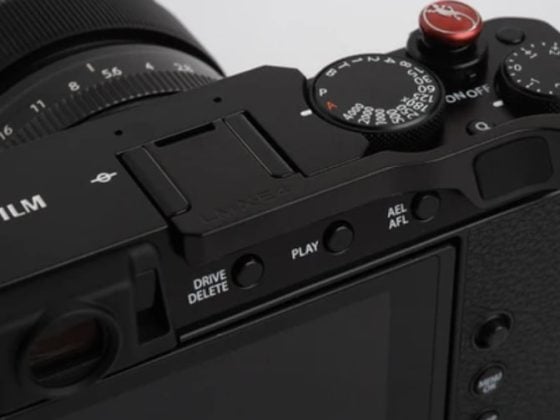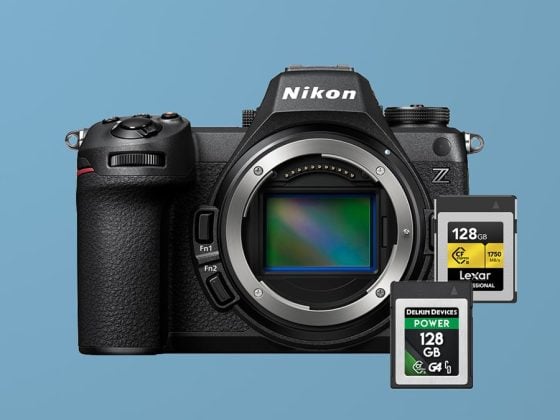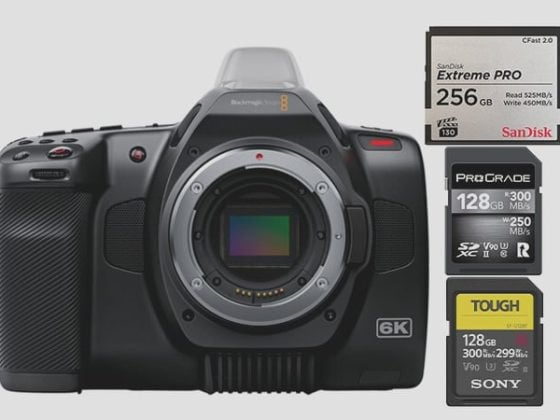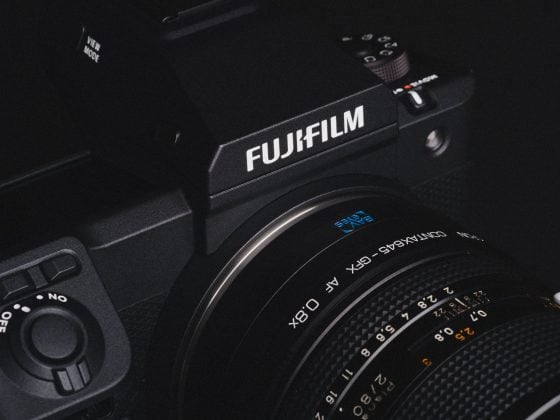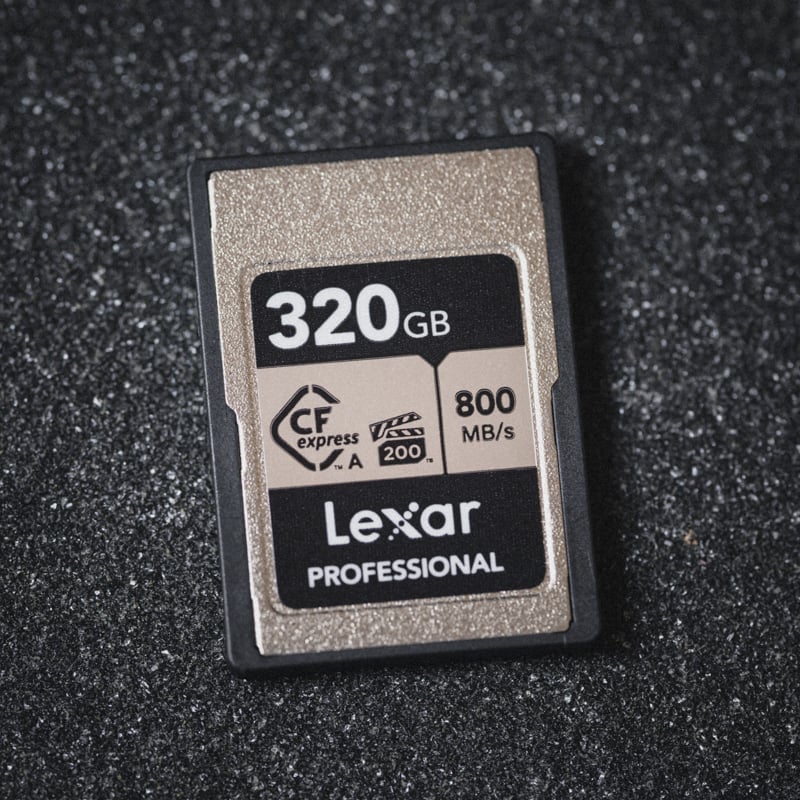
The Sony FX3 features dual memory card slots that can take V90 UHS-II SD cards or CFexpress Type-A cards.
CFexpress Type-A memory cards – Guarantee performance in all video settings, including 600Mbps H.264 (XAVC S-I) recording and the various S&Q slow-motion settings. The CF4.0 CFexpress Type-A cards also have a theoretical speed of 2000MB/s, which is great for future-proofing your set-up.
UHS-II V90 SD Memory Cards – Like the CFexpres cards, the SD UHS-II V90 cards will also allow you to use all the video modes of the Sony FX3; however, with CFexpress Type-A cards now sometimes being less expensive, these cards don’t make as much sense, and generally, it would be better to either spend a little more on a CFexpress card or go for one of the budget options.
UHS-II V60 SD Memory Cards – If you’re recording with H.265 (H.265 XAVC HS), you can use V60 UHS-II memory cards, which offer great cost savings. However, you will be limited with some of the S&Q slow motion modes, but the regular slow motion settings will still work fine.
Sony FX3 Memory Card Recommendations
If you can afford it, the Lexar Silver Type A is one of the best memory cards for the Sony FX3 as it will allow you to do everything with CFeA cards with a 200MB/s sustain guarantee and is now being priced very similar to UHS-II V90 cards; it might make sense to jump up to these faster cards now.
Also, new CF4.0 Type-A cards have much faster read and write speeds, which can be useful with file transfers. However, pay attention to sustained speeds, as that’s the most important metric for video recording. See all the CFexpress Type-A benchmarks to see how the latest cards perform.
| Recommended For Sony | USB Write | USB Read | Check Price | ||
|---|---|---|---|---|---|
| CFExpress Type-A | CFx-A | Hide | Hide | ||
| Sony G Tough 80/160/320/640GB | CFx-A | 658 | 847 | https://geni.us/wBUGRHQ | Amazon / B&H |
| Lexar Gold Series 80/160GB/320GB | CFx-A | 825 | 886 | https://geni.us/8BaVbpa | Amazon / B&H |
| Lexar Silver Series 160/320GB | CFx-A | 776 | 861 | https://geni.us/bLqRHpL | Amazon / B&H |
| Delkin Black 80GB | CFx-A | 654 | 845 | https://geni.us/9EmgQ | Amazon / B&H |
| ProGrade Iridium 480-960GB | CFx-A 4.0 | 1272 | 1532 | https://bhpho.to/3VfaVaL | B&H |
| OWC Atlas Pro 480/960GB | CFx-A 4.0 | 1275 | 1535 | B&H | |
| SD UHS-II V90 | UHS-II | Hide | Hide | ||
| Sandisk Extreme Pro V90 32-512GB | UHS-II | 268 | 293 | https://geni.us/S6WrhEt | Amazon / B&H |
| Lexar 2000x V90 32-256GB | UHS-II | 228 | 256 | https://geni.us/wV6t67K | Amazon / B&H |
| Sony G Tough v90 32-256GB | UHS-II | 258 | 296 | https://geni.us/BGrBOD | Amazon / B&H |
| Delkin Black v90 64/128/256GB | UHS-II | 253 | 278 | https://geni.us/BJA4H3n | B&H |
| Kingston Canvas React V90 32-256GB | UHS-II | 274 | 292 | https://geni.us/bz1lL | Amazon / B&H |
6 Must-Have Accessories Sony FX3
Sony FX3 Memory Card Compatibility
The Sony FX3 can take two different types of memory cards in the same slot. SD cards (UHS-I and UHS-II cards), and CFexpress type A cards.
Do you need CFexpress Type A cards For the Sony FX3?
You don’t need CFexpress Type-A cards. If you have the right V90 card, you can record in S&Q 600Mbps video.
Can You Use V60 UHS-II Cards?
If you’ve decided that you fall into the category of someone not using S&Q high frame rates, then you have a few options for UHS-II cards. V60, or v90.
V90 cards will allow you to shoot H.264 at 600Mbps, and V60 cards are all you need for H.265 video, which records at 280Mbps.
What’s the difference between CFexpress Type A and SD Cards?
The difference between these two cards mainly comes down to size and speed. CFexpress Type A cards are much faster and slightly smaller.
CFexpress Type A cards use a PCIe 3.0 Interface with a single lane of throughput. Most CFexpress cameras today use a dual-lane PCIe 2.0 CFexpress Type B interface, which should see similar speeds as a PCIe 3.0 camera. We don’t know yet if The Sony A7sIII or FX3 has such capabilities.
Memory Card Speed Test | Fastest Memory Cards
I can’t run the in-camera benchmarks in the Sony FX3 since there is no way of running a continuous burst with RAW images. However, most Sony cameras from the same generation will have similar hardware regarding memory controllers and processors. So here, we can look at memory cards for the Sony A7rV to get an idea of how the different brands work in Sony cameras.
This chart shows how the CFexpress Type-A cards perform.
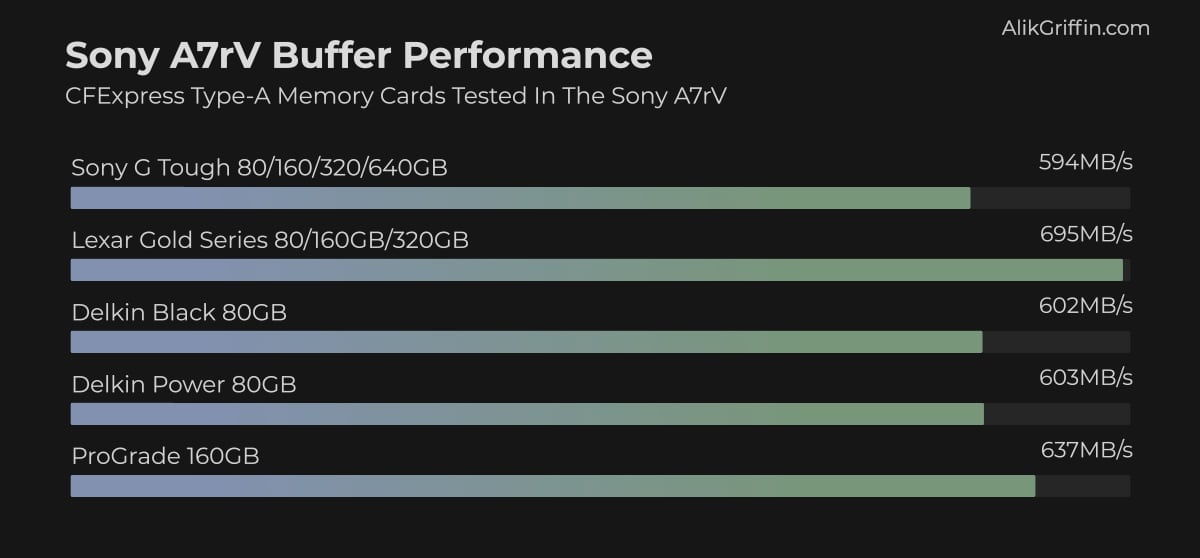
This chart shows the memory cards for the Sony A7sIII, which is a very similar camera.
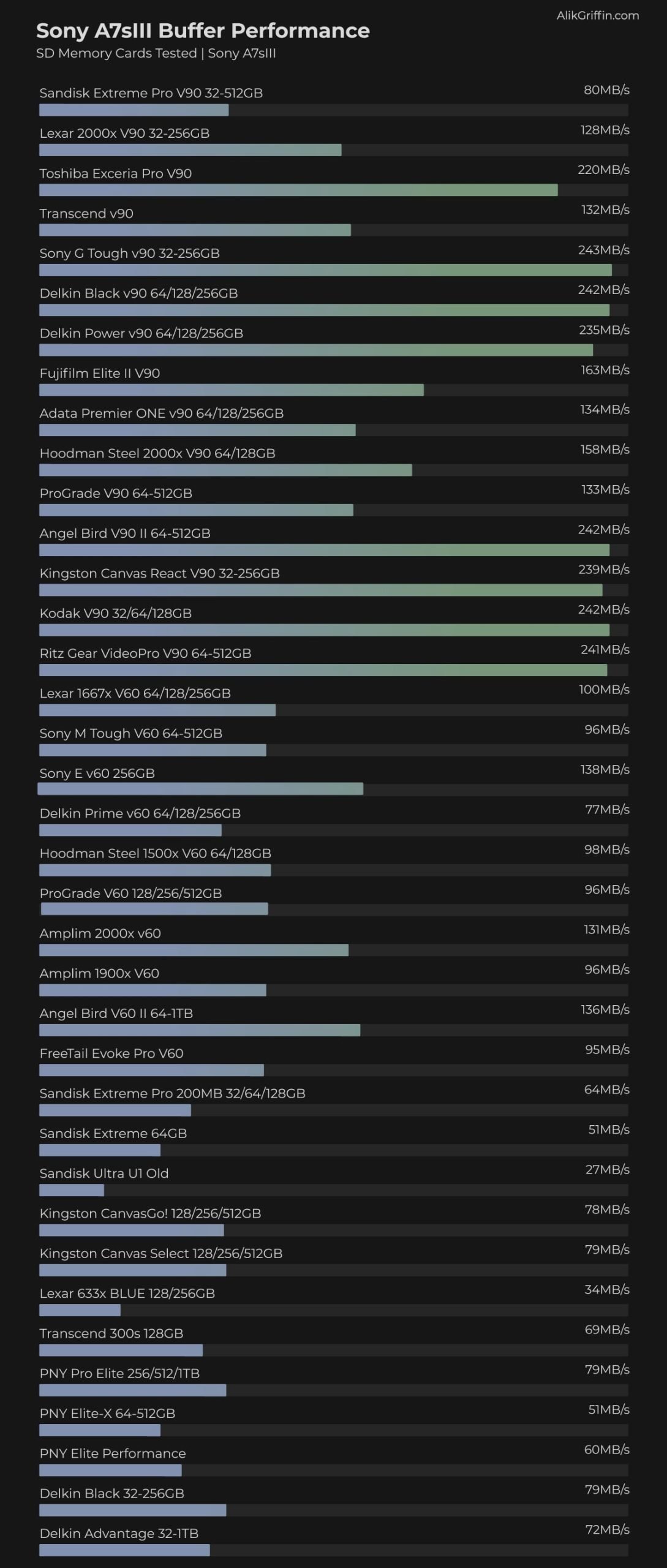
Sony FX3 Specs
| Sensor: 12MP Full-Frame Exmor R BSI CMOS Sensor Processor: BIONZ XR Image Processor Memory Card Slots: 2 UHS-II / 2 CFe A Continuous Shoot: 10fps Est. Buffer Size: — RAW Shots To Fill Buffer: 1000 Frames Max Memory Card Size: Unlimited 4k Datarate: H.265 280Mbps / H.264 600Mbps |
Here is a speed test from the Sony A9II to see how each UHS-II memory card performs in Sony cameras.
Best Memory Cards For 4k Video
Sony FX3 Video Specs & Recording Modes
With the Sony FX3, various record modes are using different codecs. It gets a little complicated, so here is the breakdown.
What’s new to the Sony FX3 compared to older Sony cameras is the XAVC HS and the XAVC S-I.
Should I Shoot XAVC HS, XAVC H-I, or XAVC S?
People often confuse the different XAVC settings with codecs. They are not the same. XAVC HS, H-I, or S are just containers that allow for different specs and capabilities.
XAVC HS allows for H.265 recording. H.265 is more efficient and packs more data into smaller file sizes than H.265.
XAVC S and S-I record to H.264. The XAVC S-I or All-I (all-intra) H.264 codec is an older AVCHD codec where each keyframe is compressed individually. Even though it is an older codec, the quality at 600Mbps is very good and should give similar results to PRORES 422.
Today, you should consider recording in H.265 if your computer can handle it. H.265 offers better compression with smaller file sizes, so the camera only outputs 280Mbps H.265 files instead of 600Mbps H.264 files. However, the image with the XAVC HS H.265 compression might be slightly softer at times due to the lack of ALL-I compression.
Sony FX3 Recording Specs & Details
Record Limit: Unlimited
Audio File Format: AAC, Linear PCM
|
4k Recording Modes |
Sony FX3 Record Times – Memory Card Capacity
This table shows the different recording modes and how much time they use for different card sizes. To get your own numbers, I have to build a bitrate-to-time converter.
| Sony FX3 Record Times | 64GB | 80GB | 128GB | 160GB | 256GB | 512GB |
| 4k | ||||||
| 4k 600Mbps | 75MB/s H.264 | 14min | 18min | 28Min | 36min | 57min | 114min |
| 4k 280Mbps | 35MB/s H.265 | 30min | 38min | 61min | 76min | 122min | 244min |
| 4k 200Mbps | 25MB/s | 43min | 53min | 85min | 107min | 171min | 341min |
| **This website contains affiliate links. We will earn a small commission on purchases made through these links. Some of the links used in these articles will direct you to Amazon. As an Amazon Associate, I earn from qualifying purchases. |

